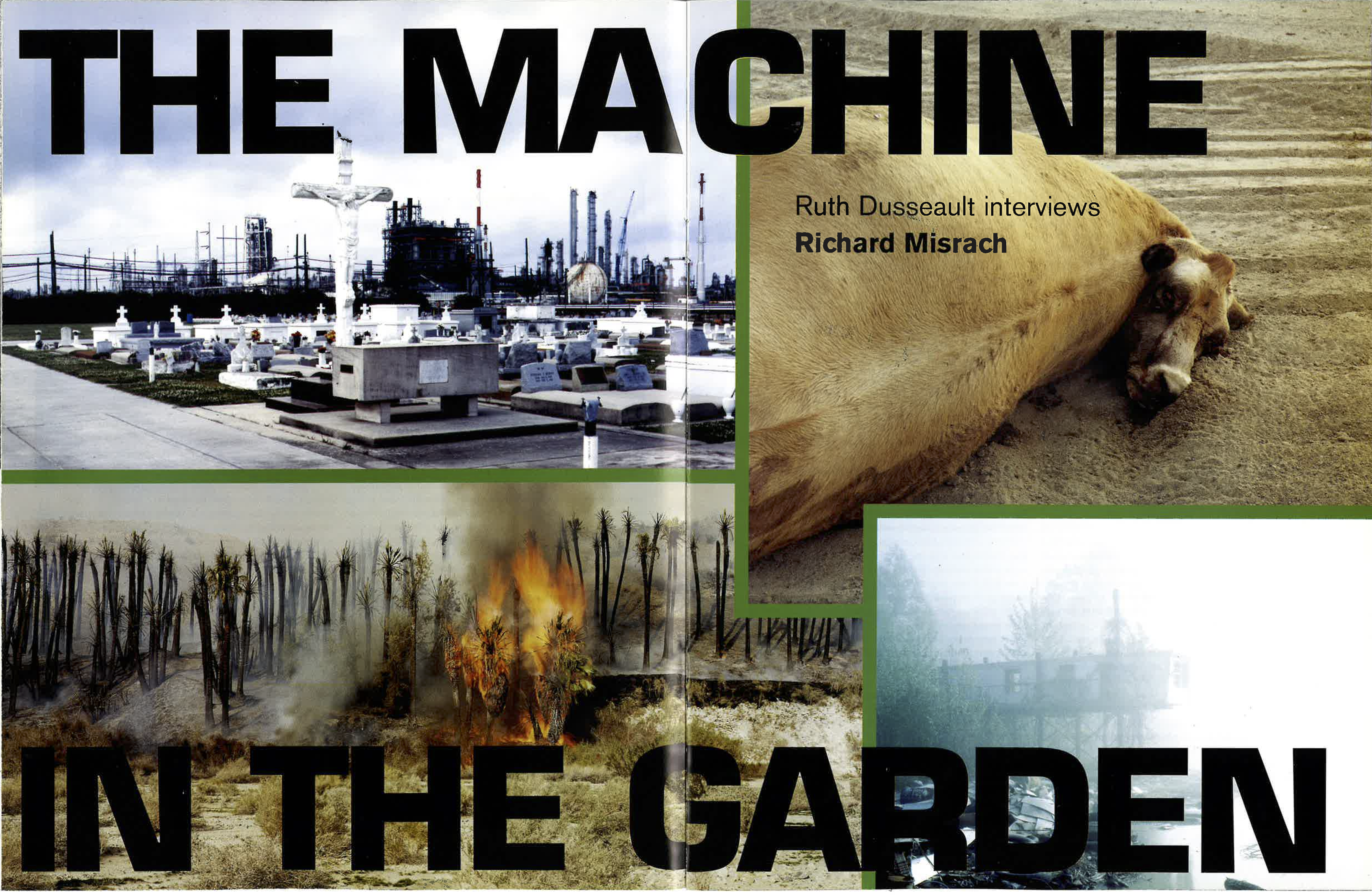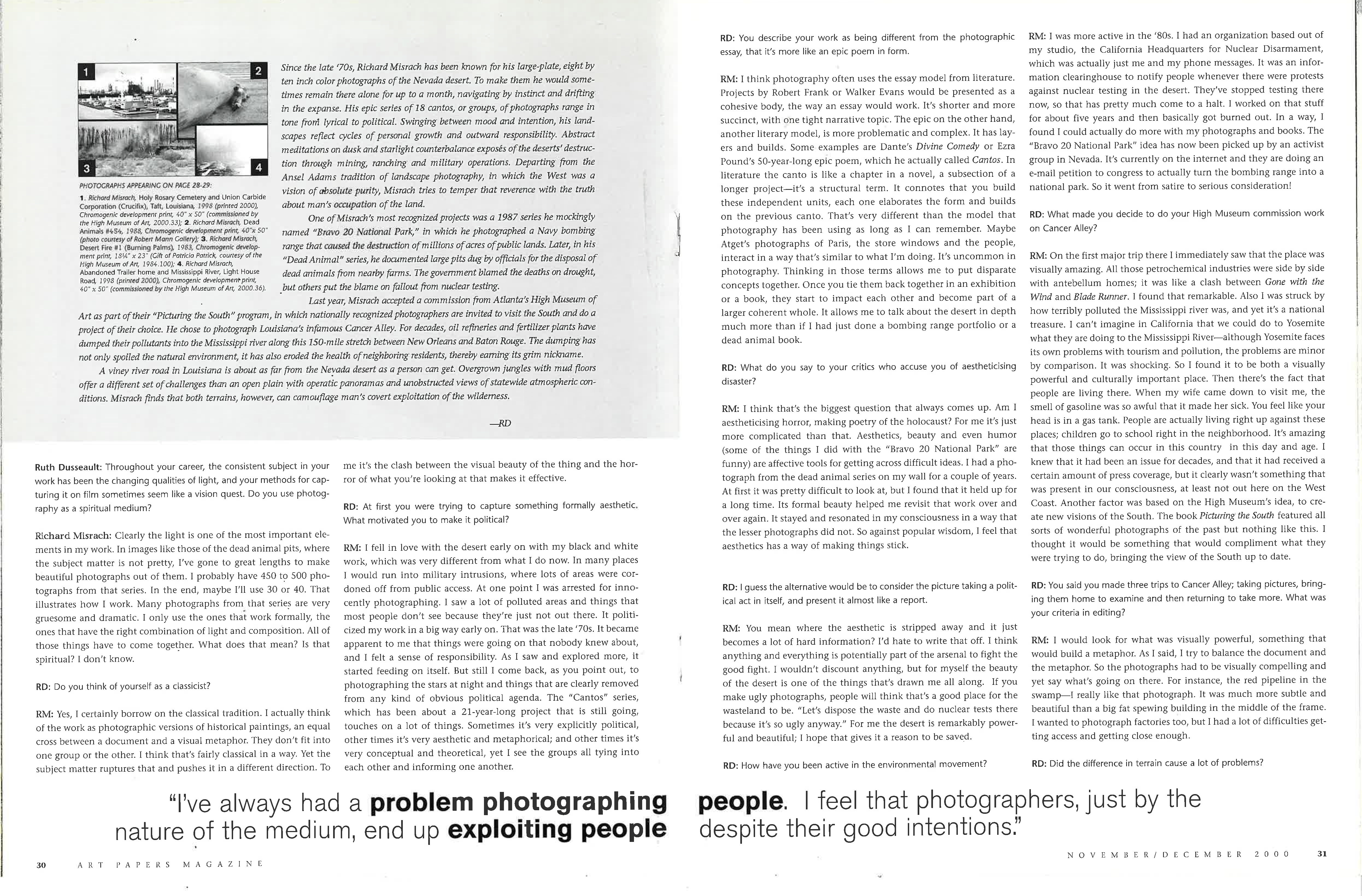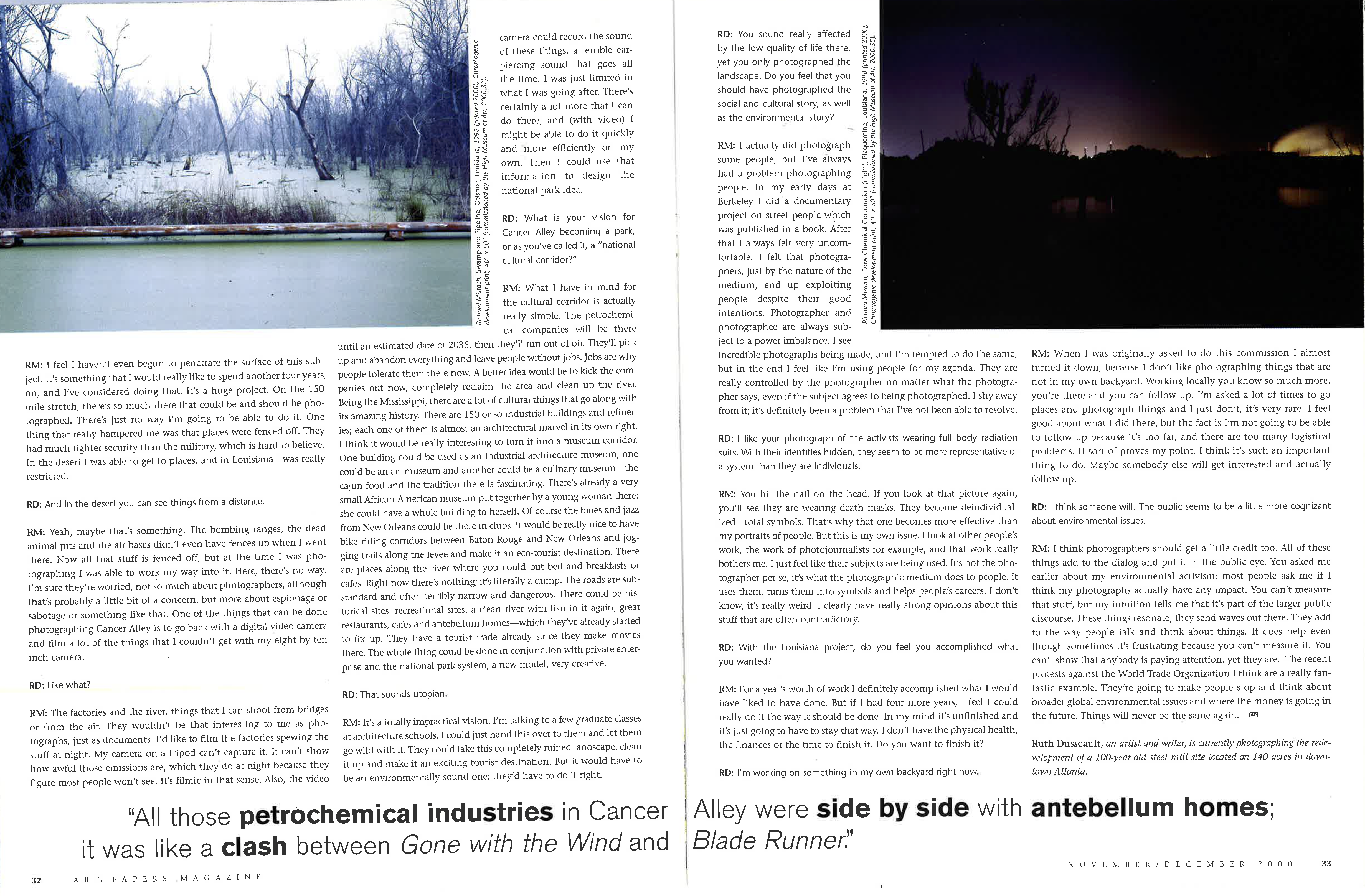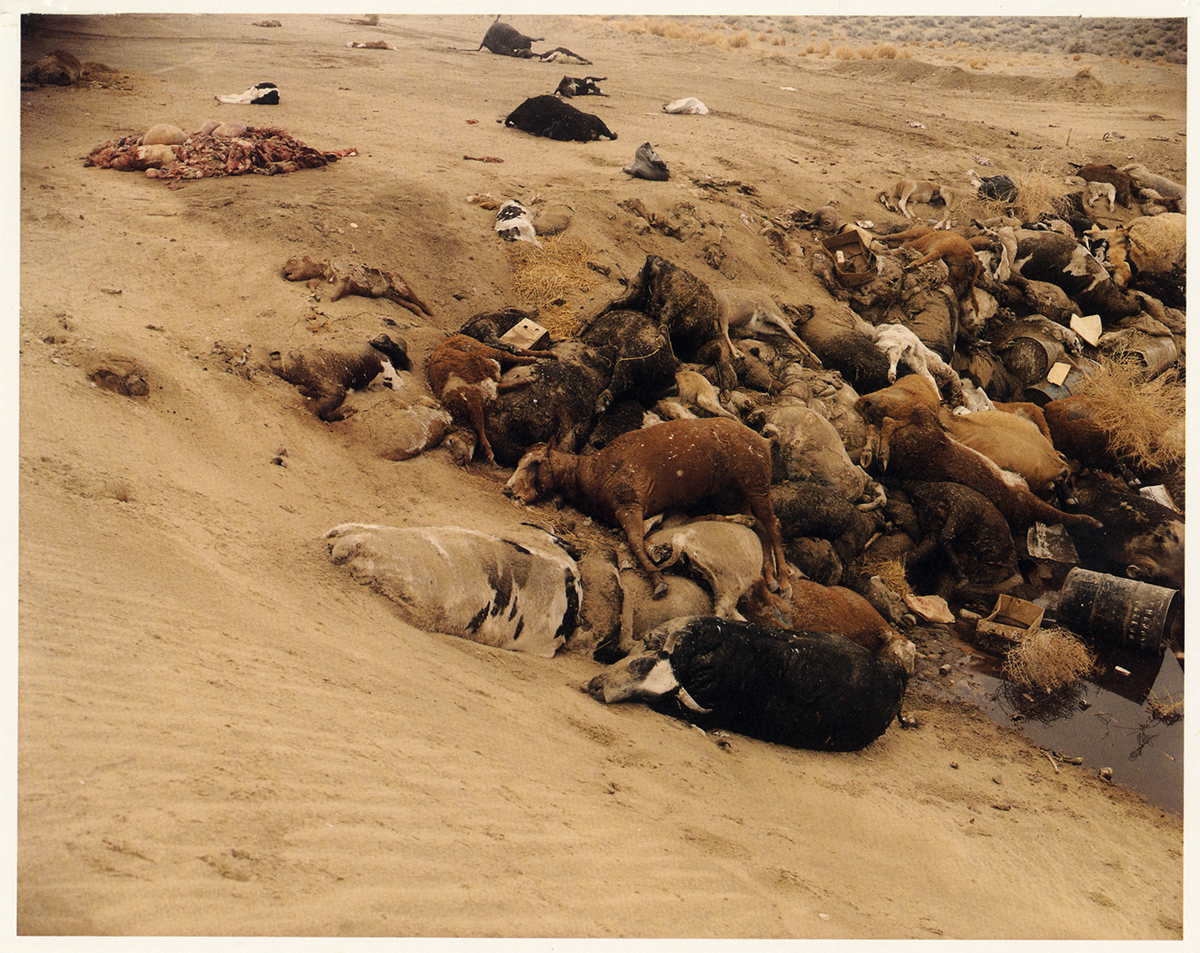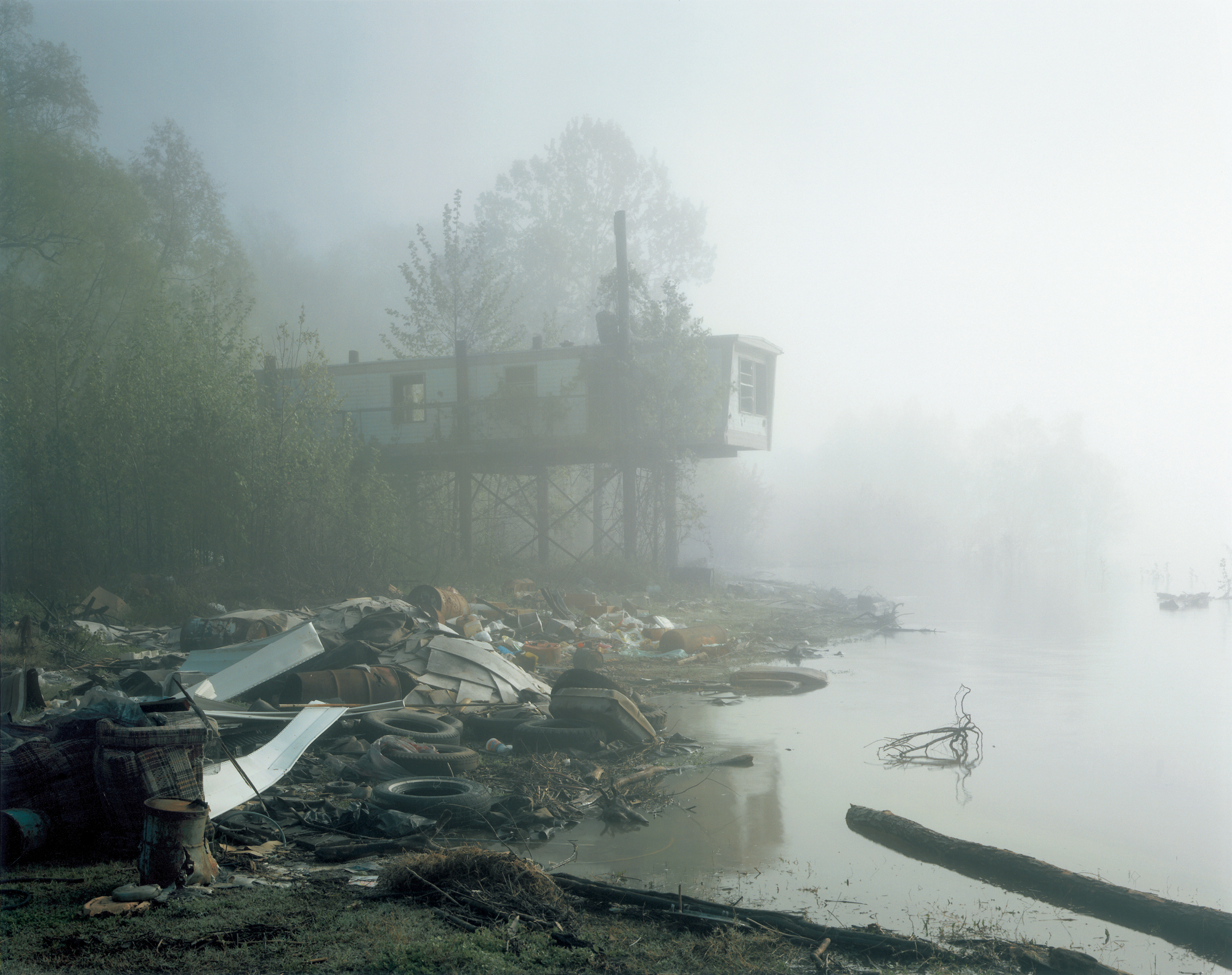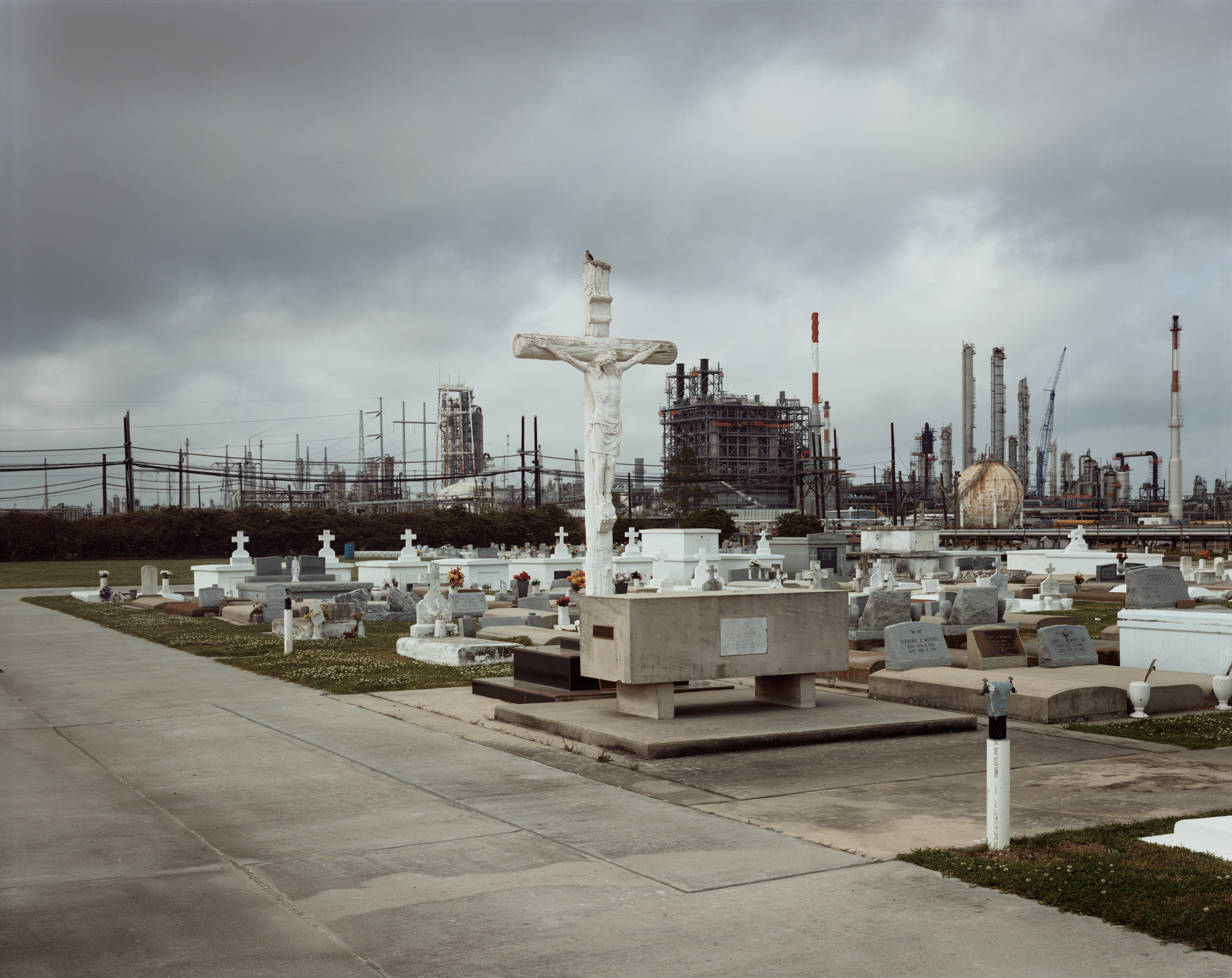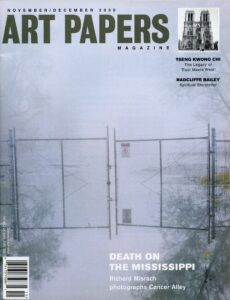Richard Misrach: The Machine in the Garden
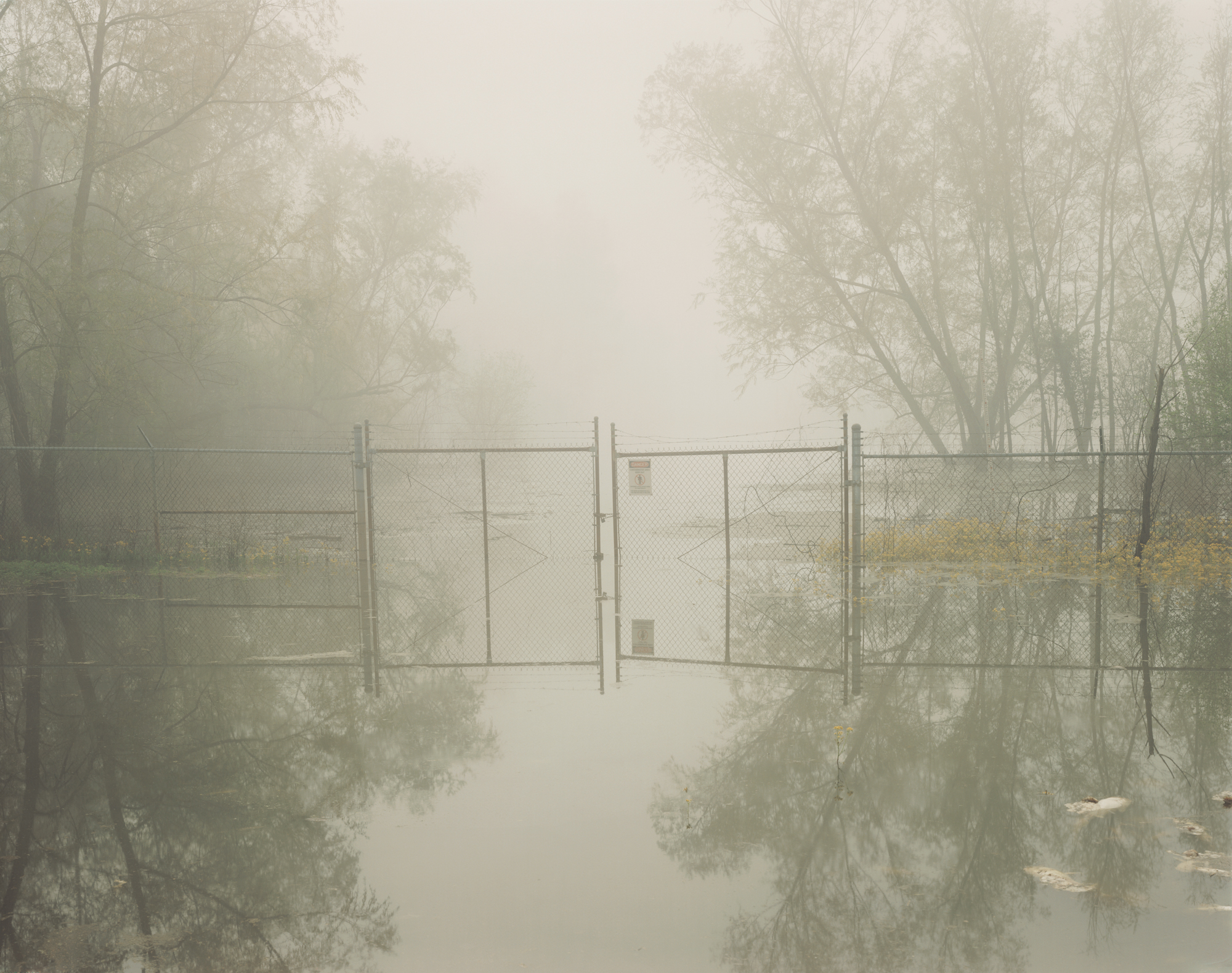
Share:
This interview was originally published in ART PAPERS November/December 2000, Vol. 24, issue 6.
Since the late ’70s, Richard Misrach has been known for his large plate, eight by ten inch color photographs of the Nevada desert. To make them he would sometimes remain there alone for up to a month, navigating by instinct and drifting In the expanse. His epic series of 18 cantas, or groups, of photographs range in tone from lyrical to political. Swinging between mood and intention, his land- scapes reflect cycles of personal growth and outward responsibility. Abstract meditations on dusk and starlight counterbalance exposés of the deserts’ destruction through mining, ranching and military operations. Departing from the Ansel Adams tradition of landscape photography, in which the West was a vision of absolute purity, Misrach tries to temper that reverence with the truth about man’s occupation of the land.
One of Misrach’s most recognized projects was a 1987 series he mockingly named “Bravo 20 National Park,” in which he photographed a Navy bombing range that caused the destruction of millions of acres of public lands. Later, in his “Dead Animal” series, he documented large pits dug by officials for the disposal of dead animals from nearby farms. The government blamed the deaths on drought, but others put the blame on fallout from nuclear testing.
Last year, Misrach accepted a commission from Atlanta’s High Museum of Art as part of their “Picturing the South” program, in which nationally recognized photographers are invited to visit the South and do a project of their choice. He chose to photograph Louisiana’s infamous Cancer Alley. For decades, oil refineries and fertilizer plants have dumped their pollutants into the Mississippi river along this 150-mile stretch between New Orleans and Baton Rouge. The dumping has not only spoiled the natural environment, it has also eroded the health of neighboring residents, thereby earning its grim nickname.
A viney river road in Louisiana is about as far from the Nevada desert as a person can get. Overgrown jungles with mud floors offer a different set of challenges than an open plain with operatic panoramas and unobstructed views of statewide atmospheric conditions. Misrach finds that both terrains, however, can camouflage man’s covert exploitation of the wilderness.
– Ruth Dusseault
Original lay out of this interview in the November / December issue ART PAPERS in 2000.
Ruth Dusseault: Throughout your career, the consistent subject in your work has been the changing qualities of light, and your methods for capturing it on film sometimes seem like a vision quest. Do you use photography as a spiritual medium?
Richard Misrach: Clearly the light is one of the most important elements in my work. In images like those of the dead animal pits, where the subject matter is not pretty, I’ve gone to great lengths to make beautiful photographs out of them. I probably have 450 to 500 photographs from that series. In the end, maybe I’ll use 30 or 40. That illustrates how I work. Many photographs from that series are very gruesome and dramatic. I only use the ones that work formally, the ones that have the right combination of light and composition. All of those things have to come together. What does that mean? Is that spiritual? I don’t know.
RD: Do you think of yourself as a classicist?
RM: Yes, I certainly borrow on the classical tradition. I actually think of the work as photographic versions of historical paintings, an equal cross between a document and a visual metaphor. They don’t fit into one group or the other. I think that’s fairly classical in a way. Yet the subject matter ruptures that and pushes it in a different direction. To me it’s the clash between the visual beauty of the thing and the horror of what you’re looking at that makes it effective.
RD: At first you were trying to capture something formally aesthetic. What motivated you to make it political?
RM: I fell in love with the desert early on with my black and white work, which was very different from what I do now. In many places I would run into military intrusions, where lots of areas were cordoned off from public access. At one point I was arrested for innocently photographing. I saw a lot of polluted areas and things that most people don’t see because they’re just not out there. It politicized my work in a big way early on. That was the late ’70s. It became apparent to me that things were going on that nobody knew about, and I felt a sense of responsibility. As I saw and explored more, it started feeding on itself. But still I come back, as you point out, to photographing the stars at night and things that are clearly removed. from any kind of obvious political agenda. The “Cantos” series, which has been about a 21-year-long project that is still going, touches on a lot of things. Sometimes it’s very explicitly political, other times it’s very aesthetic and metaphorical; and other times it’s very conceptual and theoretical, yet I see the groups all tying into each other and informing one another.
RD: You describe your work as being different from the photographic essay, that it’s more like an epic poem in form.
RM: I think photography often uses the essay model from literature. Projects by Robert Frank or Walker Evans would be presented as a cohesive body, the way an essay would work. It’s shorter and more succinct, with one tight narrative topic. The epic on the other hand, another literary model, is more problematic and complex. It has layers and builds. Some examples are Dante’s Divine Comedy or Ezra Pound’s 50-year-long epic poem, which he actually called Cantos. In literature the canto is like a chapter in a novel, a subsection of a longer project—it’s a structural term. It connotes that you build these independent units, each one elaborates the form and builds on the previous canto. That’s very different than the model that photography has been using as long as I can remember. Maybe Atget’s photographs of Paris, the store windows’ and the people, interact in a way that’s similar to what I’m doing. It’s uncommon in photography. Thinking in those terms allows me to put disparate concepts together. Once you tie them back together in an exhibition or a book, they start to impact each other and become part of a larger coherent whole. It allows me to talk about the desert in depth much more than if I had just done a bombing range portfolio or a dead animal book.
RD: What do you say to your critics who accuse you of aestheticising disaster?
RM: I think that’s the biggest question that always comes up. Am I aestheticising horror, making poetry of the holocaust? For me it’s just more complicated than that. Aesthetics, beauty and even humor (some of the things I did with the “Bravo 20 National Park” are funny) are affective tools for getting across difficult ideas. I had a photograph from the dead animal series on my wall for a couple of years. At first it was pretty difficult to look at, but I found that it held up for a long time. Its formal beauty helped me revisit that work over and over again. It stayed and resonated in my consciousness in a way that the lesser photographs did not. So against popular wisdom, I feel that aesthetics has a way of making things stick.
RD: I guess the alternative would be to consider the picture taking a political act in itself, and present it almost like a report.
RM: You mean where the aesthetic is stripped away and it just becomes a lot of hard information? I’d hate to write that off. I think anything and everything is potentially part of the arsenal to fight the good fight. I wouldn’t discount anything, but for myself the beauty of the desert is one of the things that’s drawn me all along. If you make ugly photographs, people will think that’s a good place for the wasteland to be. “Let’s dispose the waste and do nuclear tests there because it’s so ugly anyway.” For me the desert is remarkably powerful and beautiful; I hope that gives it a reason to be saved.
RD: How have you been active in the environmental movement?
RM: I was more active in the ’80s. I had an organization based out of my studio, the California Headquarters for Nuclear Disarmament, which was actually just me and my phone messages. It was an information clearinghouse to notify people whenever there were protests against nuclear testing in the desert. They’ve stopped testing there now, so that has pretty much come to a halt. I worked on that stuff for about five years and then basically got burned out. In a way, I found I could actually do more with my photographs and books. The “Bravo 20 National Park” idea has now been picked up by an activist group in Nevada. It’s currently on the internet and they are doing an e-mail petition to congress to actually turn the bombing range into a national park. So it went from satire to serious consideration!
RD: What made you decide to do your High Museum commission work on Cancer Alley?
RM: On the first major trip there I immediately saw that the place was visually amazing. All those petrochemical industries were side by side with antebellum homes; it was like a clash between Gone with the Wind and Blade Runner. I found that remarkable. Also I was struck by how terribly polluted the Mississippi river was, and yet it’s a national treasure. I can’t imagine in California that we could do to Yosemite what they are doing to the Mississippi River—although Yosemite faces its own problems with tourism and pollution, the problems are minor by comparison. It was shocking. So I found it to be both a visually powerful and culturally important place. Then there’s the fact that people are living there. When my wife came down to visit me, the smell of gasoline was so awful that it made her sick. You feel like your head is in a gas tank. People are actually living right up against these places; children go to school right in the neighborhood. It’s amazing that those things can occur in this country in this day and age. I knew that it had been an issue for decades, and that it had received a certain amount of press coverage, but it clearly wasn’t something that was present in our consciousness, at least not out here on the West Coast. Another factor was based on the High Museum’s idea, to create new visions of the South. The book Picturing the South featured all sorts of wonderful photographs of the past but nothing like this. I thought it would be something that would compliment what they were trying to do, bringing the view of the South up to date.
Richard Misrach, Abandoned Trailer Home, Mississippi River, near Dow Chemical Plant, Plaquemine, Louisiana, 1998, pigment print, 30 x 37 inches © Richard Misrach; courtesy Fraenkel Gallery, San Francisco]
RD: You said you made three trips to Cancer Alley; taking pictures, bringing them home to examine and then returning to take more. What was your criteria in editing?
RM: I would look for what was visually powerful, something that would build a metaphor. As I said, I try to balance the document and the metaphor. So the photographs had to be visually compelling and yet say what’s going on there. For instance, the red pipeline in the swamp—I really like that photograph. It was much more subtle and beautiful than a big fat spewing building in the middle of the frame. I wanted to photograph factories too, but I had a lot of difficulties getting access and getting close enough.
RD: Did the difference in terrain cause a lot of problems?
RM: I feel I haven’t even begun to penetrate the surface of this subject. It’s something that I would really like to spend another four years on, and I’ve considered doing that. It’s a huge project. On the 150 mile stretch, there’s so much there that could be and should be photographed. There’s just no way I’m going to be able to do it. One thing that really hampered me was that places were fenced off. They had much tighter security than the military, which is hard to believe. In the desert I was able to get to places, and in Louisiana I was really restricted.
RD: And in the desert you can see things from a distance,
RM: Yeah, maybe that’s something. The bombing ranges, the dead animal pits and the air bases didn’t even have fences up when I went there. Now all that stuff is fenced off, but at the time I was photographing I was able to work my way into it. Here, there’s no way. I’m sure they’re worried, not so much about photographers, although that’s probably a little bit of a concern, but more about espionage or sabotage or something like that. One of the things that can be done photographing Cancer Alley is to go back with a digital video camera and film a lot of the things that I couldn’t get with my eight by ten inch camera.
RD: Like what?
RM: The factories and the river, things that I can shoot from bridges or from the air. They wouldn’t be that interesting to me as photographs, just as documents. I’d like to film the factories spewing the stuff at night. My camera on a tripod can’t capture it. It can’t show how awful those emissions are, which they do at night because they figure most people won’t see. It’s filmic in that sense. Also, the video camera could record the sound of these things, a terrible piercing sound that goes all the time. I was just limited in what I was going after. There’s certainly a lot more that I can do there, and (with video I might be able to do it quickly and more efficiently on my own. Then I could use the information to design the national park idea.
RD: What is your vision for Cancer Alley becoming a park, or as you’ve called it, a “national cultural corridor?”
RM: What I have in mind for the cultural corridor is actually really simple. The petrochemical companies will be there until an estimated date of 2035, then they’ll run out of oil. They’ll pick up and abandon everything and leave people without jobs. Jobs are why people tolerate them there now. A better idea would be to kick the companies out now, completely reclaim the area and clean up the river. Being the Mississippi, there are a lot of cultural things that go along with its amazing history. There are 150 or so industrial buildings and refineries, each one of them is almost an architectural marvel in its own right. I think it would be really interesting to turn it into a museum corridor. One building could be used as an industrial architecture museum, one could be an art museum and another could be a culinary museum—the cajun food and the tradition there is fascinating. There’s already a very small African-American museum put together by a young woman there, she could have a whole building to herself. Of course the blues and jazz from New Orleans could be there in clubs. It would be really nice to have bike riding corridors between Baton Rouge and New Orleans and jogging trails along trails along the levee and make it an eco-tourist destination. There are places along the river where you could put bed and breakfasts or cafes. Right now there’s nothing; it’s literally a dump. The roads are substandard and often terribly narrow and dangerous. There could be historical sites, recreational sites, a clean river with fish in it again, great restaurants, cafes and antebellum homes—which they’ve already started to fix up. They have a tourist trade already since they make movies there. The whole thing could be done in conjunction with private enterprise and the national park system, a new model, very creative.
RD: That sounds utopian.
RM: It’s a totally impractical vision. I’m talking to a few graduate classes at architecture schools, I could just hand this over to them and let them go wild with it. They could take this completely ruined landscape, clean it up and make it an exciting tourist destination. But it would have to be an environmentally sound one; they’d have to do it right.
RD: You sound really affected by the low quality of life there, yet you only photographed the landscape. Do you feel that you should have photographed the social and cultural story, as well as the environmental story?
RM: I actually did photograph some people, but I’ve always had a problem photographing people. In my early days at Berkeley I did a documentary project on street people which was published in a book. After that I always felt very uncomfortable. I felt that photographers, just by the nature of the medium, end up exploiting people despite their good intentions. Photographer and Photographee are always subject to power imbalance. I see incredible photographs being made, and I’m tempted to do the same, but in the end I feel like I’m using people for my agenda. They are really controlled by the photographer no matter what the photographer says, even if the subject agrees to being photographed. I shy away from it; it’s definitely been a problem that I’ve not been able to resolve.
Richard Misrach, Holy Rosary Cemetery and Union Carbide Complex, Taft, Louisiana, 1998, pigment print, 20 x 24 inches © Richard Misrach; courtesy Fraenkel Gallery, San Francisco]
RD: I like your photograph of the activists wearing full body radiation suits. With their identities hidden, they seem to be more representative of a system than they are individuals.
RM: You hit the nail on the head. If you look at that picture again, you’ll see they are wearing death masks. They become deindividualized—total symbols. That’s why that one becomes more effective than my portraits of people. But this is my own issue. I look at other people’s work, the work of photojournalists for example, and that work really bothers me. I just feel like their subjects are being used. It’s not the photographer per se, it’s what the photographic medium does to people. It uses them, turns them into symbols and helps people’s careers. I don’t know, it’s really weird. I clearly have really strong opinions about this stuff that are often contradictory.
RD: With the Louisiana project, do you feel you accomplished what you wanted?
RM: For a year’s worth of work I definitely accomplished what I would have liked to have done. But if I had four more years, I feel I could really do it the way it should be done. In my mind it’s unfinished and it’s just going to have to stay that way. I don’t have the physical health, the finances or the time to finish it. Do you want to finish it?
RD: I’m working on something in my own backyard right now,
RM: When I was originally asked to do this commission I almost turned it down, because I don’t like photographing things that are not in my own backyard. Working locally you know so much more, you’re there and you can follow up. I’m asked a lot of times to go places and photograph things and I just don’t; it’s very rare. I feel good about what I did there, but the fact is I’m not going to be able to follow up because it’s too far, and there are too many logistical problems. It sort of proves my point. I think it’s such an important thing to do. Maybe somebody else will get interested and actually follow up.
RD: I think someone will. The public seems to be a little more cognizant about environmental issues.
RM: I think photographers should get a little credit too. All of these things add to the dialog and put it in the public eye. You asked me earlier about my environmental activism; most people ask me if I think my photographs actually have any impact. You can’t measure that stuff, but my intuition tells me that it’s part of the larger public discourse. These things resonate, they send waves out there. They add to the way people talk and think about things. It does help even though sometimes it’s frustrating because you can’t measure it. You can’t show that anybody is paying attention, yet they are. The recent protests against the World Trade Organization I think are a really fantastic example. They’re going to make people stop and think about broader global environmental issues and where the money is going in the future. Things will never be the same again.
Ruth Dusseault is an environmental journalist with multi-discipline experience in film, geography, ethnography and design. She reports on systems that undergird modern life. Her avenues include architecture, environmental engineering, food systems and public policy.
